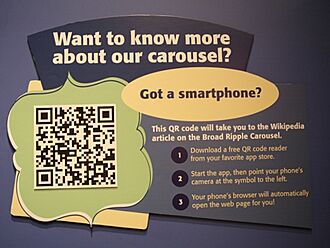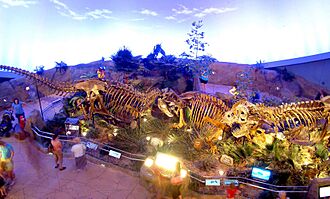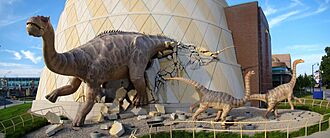The Children's Museum of Indianapolis facts for kids
 |
|
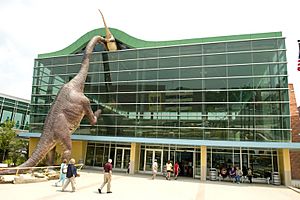
Welcome Center and Brachiosaurus, installed in 2009
|
|
| Established | 1925 |
|---|---|
| Location | 3000 North Meridian Street, Indianapolis, Indiana, 46208-4716, U.S. |
| Type | Children's museum |
| Visitors | 1.3 million (2019) |
| Public transit access | |
The Children's Museum of Indianapolis is the biggest children's museum in the world! It is located at 3000 North Meridian Street in Indianapolis, Indiana. This museum is officially recognized by the American Alliance of Museums.
The museum is huge, covering 472,900 square feet (43,933.85 m2) with five floors of amazing exhibits. More than one million people visit it every year. It has a collection of over 130,000 items. These items are split into two main groups: Arts & Humanities and Natural Sciences. You can see cool things like dinosaur habitats, a fun carousel, a real steam locomotive, and a giant glass sculpture called Fireworks of Glass Tower and Ceiling. The museum is all about families learning together. Most exhibits are designed so you can touch and interact with them.
The museum was started in 1925 by Mary Stewart Carey. She got help from local leaders and groups. It is the fourth-oldest children's museum in the world. The museum moved to its current spot in 1946. The building you see today was built in 1976. It has been made bigger four times since then. The museum hosts thousands of activities each year. These include plays at the Lilly Theater, classes for school kids, and special traveling exhibits. Jennifer Pace Robinson became the museum's president and CEO in May 2021.
Museum History
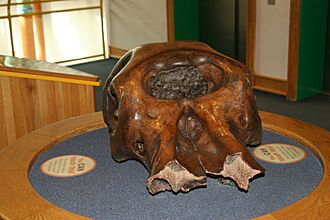
How the Museum Started
The Children's Museum of Indianapolis was founded in 1925. A wealthy woman named Mary Stewart Carey started it. She owned a glass company and loved helping her community. Mary was inspired after visiting the Brooklyn Children's Museum in 1924. She decided to create a similar museum in Indianapolis.
Mary got help from other local leaders and teachers. The museum first opened in a carriage house. This was part of a local club called The Propylaeum. A group of trustees was formed to run the museum. Mary Carey was chosen as its first president. Early exhibits were made and given by school children.
Early Growth and New Leadership
Mary Carey wanted a bigger place for the museum. After moving twice, she finally put the museum in her own mansion in 1926. That same year, Arthur Carr was hired as the first curator. He organized Mary's collections into exhibits. He also managed the museum. The first permanent exhibits were about marine life, Japan, pioneers, archaeology, and nature.
By the 1940s, the museum had more staff. Arthur Carr became the director after Mary Carey passed away in 1938. The museum started giving tours to school children. They also created traveling exhibits that went to different schools. They began holding events to raise money. Young members of the museum received a special Seahorse pin.
In 1942, Grace Golden became the new director. She wanted to make the museum even bigger. Grace got money from different foundations and families. She also got support from several companies. This new money helped the museum buy its own building. It was a large mansion on North Meridian Street.
Grace Golden also started getting exhibits from other places. She didn't just rely on local donations. She worked with other museums. They loaned exhibits of Native American artifacts in 1947. A gallery of dinosaur skeletons arrived in 1949. A real mummy named Wenuhotep came in 1959. A log cabin from the 1800s was donated in 1961. The Hall of Man was added in 1962. New permanent exhibits were created during her time. These focused on pioneer life, natural science, and different cultures. Grace also started a Junior Docent program. She created two weekly TV shows for local broadcast. She also began a program of interactive activities.
Building the Modern Museum
Mildred Compton became director in 1964. She stayed until 1982. Mildred made the first long-term financial plans for the museum. She started an endowment, which is like a savings account for the museum. She also began advertising to get donations and more visitors. The museum improved its exhibits and records. This helped it get official recognition from the American Alliance of Museums.
In 1973, a fundraising effort collected $8.7 million. This money allowed the museum to build its current home. The old museum was taken down, and the new one was built in the same spot. The new museum opened in 1976. It had modern storage for its collections. It also had classrooms and a large theater. The exhibit area was much bigger, with five floors. New exhibits were added for the grand opening. These included a carousel, a pretend cave, and a mastodon skeleton.
Peter Sterling became director in 1982. He continued to help the museum grow. A restaurant and an outdoor garden were added in 1983. In 1984, a huge collection of 50,000 folk art items was donated. This collection nearly doubled the number of items the museum owned. The museum also started a $14 million expansion. This included a new welcome center and entrance. A planetarium and another exhibit hall were also added. These were finished in 1988.
By 1992, the museum was hosting 4,000 programs each year. About 835,000 people visited annually. The museum had many employees and volunteers. In 1996, a large movie theater called the CineDome was built next to the museum. In 2004, the CineDome was changed into Dinosphere. This popular dinosaur exhibit is built inside and around the old theater. The Welcome Center was made bigger again in 2009. This made the museum's total size 472,900 square feet (43,930 m2).
Jennifer Pace Robinson became the museum's president and CEO in 2021. She had worked at the museum for 29 years before that.
How the Museum Works
The museum had over one million visitors in 2008. More than 83,000 students visited on school field trips that year. In 2010, the museum had 400 full-time and part-time employees. Also, 1,500 volunteers help out for over 65,000 hours each year.
The main museum building has five floors of exhibit halls. There are also smaller buildings around it. These include Dinosphere, a theater, and an outdoor sports park. The museum has a collection of over 130,000 artifacts. These are divided into Arts & Humanities and Natural Science.
The museum works hard to keep its exhibits fresh and new. Experts are often asked for ideas for new exhibits. The museum employs many experts who are leaders in their fields. Because of its great ideas, the museum is a world leader in its area. Child and Parents magazines have both called it the best children's museum in the United States. It is seen as the "gold standard" for children's museums. The museum also makes sure its exhibits are good for visitors with sensory issues.
The museum even had a Wikipedian in Residence starting in 2011. They also use QRpedia codes. These codes let visitors use their phones to read Wikipedia articles about the exhibits. The articles can be translated into different languages. For example, you can find QRpedia codes at the "All Aboard!" exhibit. This code links to the article about the Reuben Wells steam engine. Another code is at the Carousel Wishes and Dreams exhibit. It links to the Broad Ripple Park Carousel article.
Museum Exhibits
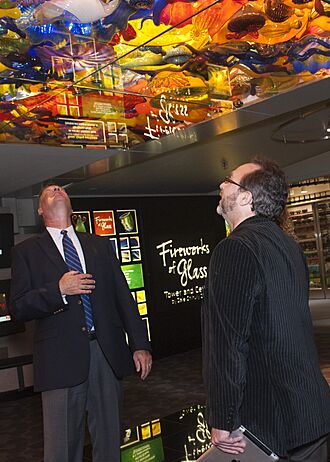
The main staircase in the museum is a giant spiral ramp. This ramp lets visitors easily reach all five levels. You can use strollers, wheelchairs, and walkers on it. In 2006, a famous glass artist named Dale Chihuly created a four-story glass sculpture. It is inside the central part of the spiral ramp. The sculpture is called Fireworks of Glass Tower and Ceiling. There is also an exhibit that shows how Chihuly makes his glass art.
Lower Level Adventures
The National Geographic: Treasures of the Earth exhibit is on the Lower Level. It opened in 2011. This exhibit has three parts. One part shows ancient Egyptian artifacts. It looks like a copy of the tomb of Seti I. Another area is a pretend archaeological dig. Here, you can learn about artifacts from Ying Zheng, the first Emperor of China. The third area explores underwater archaeology. It features a shipwreck from the Dominican Republic that belonged to Captain Kidd. You can even see cannons from it. There is also a working lab at the back.
The Beyond Spaceship Earth gallery opened in 2016. It teaches you about technology and daily life on NASA's space stations. It also has an Indiana Astronaut Wall of Fame.
The "All Aboard!" Gallery features a huge 11,000-pound (5,000 kg) steam engine. It was designed by Reuben Wells in 1868. This engine was built to climb Indiana's Madison Hill. The engine is connected to a Pennsylvania Railroad tool car in the exhibit.
The Lilly Theater is also on the lower level.
Main Floor Fun
On the main floor, you'll find the Welcome Center. It has large sculptures of adult and baby Brachiosaurs climbing into the front. These sculptures look very real based on what scientists know about dinosaurs. They were made by Gary Staab and painted by Brian Cooley. Outside the museum on this level, there is the Seven Wonders of the World garden. There is also a green rain garden and parking areas.
A main attraction on the ground level is North America's largest water clock. It was created by a French scientist and artist named Bernard Gitton. The main floor also has the museum's toy store and a food court. You can also find the volunteer center and birthday party rooms here.
Second Floor Explorations
The museum has a 3,000-square-foot (280 m2) branch of the Indianapolis Public Library. It is called the InfoZone. This library space moved to the second floor in 2009. It is located outside the skywalk that connects the parking garage to the main building.
The second level hosts many of the museum's temporary exhibits. These exhibits change often. The only semi-permanent exhibit on this level is the "Take Me There" gallery. The content of this exhibit changes every four to five years. It features a different culture each time. For example, "Take Me There: Egypt" was shown in 2009. "Take Me There: China" and "Take Me There: Greece" followed. "Take Me There: Peru" opened in July 2025. This floor also has small displays showing different rooms and their decorations.
"Stories from our Community" opened in July 2012. This display shows items that tell stories from people in the community. Visitors can sit at touch-screen displays. They can choose which stories they want to listen to or read. There is also a website that shares these stories and more.
Third Floor Discoveries
The third level features "The Power of Children: Making a Difference". This is a permanent exhibit. It tells the stories of Anne Frank, Ruby Bridges, Ryan White, and Malala Yousafzai. It shows how these children made a big impact on the world. The goal of this exhibit is to help people understand and talk about prejudice and discrimination. It encourages finding solutions to these problems.
The exhibit recreates the places where each child lived. These environments are very accurate. Actors and live theater help visitors understand the lives of Frank, Bridges, White, and Yousafzai. The gallery uses sounds, lighting, quotes, and interactive displays. These elements draw visitors into the exhibit.
The second exhibit on the third floor is Playscape. This is a learning and play area for children aged 5 and younger. It first opened in 1981. The museum completely updated Playscape in 2013. The new gallery kept many popular features. These include a large sandbox, a water play area, and a special spot for babies and toddlers.
Fourth Floor Wonders
One of the museum's most popular attractions is the Broad Ripple Park Carousel. It is in the Carousel Wishes and Dreams gallery on the fourth floor. The carousel animals were made by the Dentzel company. It was first set up in White City Amusement Park in 1917. The museum restored it and put it here in 1973. It is the largest item the museum owns. The carousel is a National Historic Landmark. The music comes from a rare Wurlitzer style #146-B Military Band Organ.
The fourth level also has Science Works. This exhibit used to be called Science Spectrum. It is all about exploring natural science and physical science through building activities. Kids can build toy boats to float in a waterway. They can play in a construction zone or build an arch. There's also a rock wall to climb and tunnels to crawl through. You can observe a live pond and do other activities. Inside Science Works is the Biotech Lab. It hosts daily events about the future of DNA and chemistry. SciencePort focuses on plant biology.
Dinosphere: A Dinosaur Adventure
Dinosphere connects to the main museum on the Lower Level (through All Aboard!), Level One (near the food court), and Level Two. Dinosphere used to be a movie theater called the CineDome. Now, it has sounds and lights that make you feel like you're in the late Cretaceous period, 65 million years ago.
The center of the exhibit has three fossil scenes. Visitors can pretend to dig for fossils in the Dig Site. You can touch a real Tyrannosaurus rex leg bone in the Paleo Prep Lab. You can even talk to real paleontologists. There are also fun games and touch-screen activities. Many real dinosaur fossils from the Cretaceous period are on display. Dinosphere has one of the largest collections of young and family dinosaur fossils in the U.S.
The exhibit features several types of dinosaurs. These include Hypacrosaurus, Prenoceratops, Tyrannosaurus rex, Triceratops, Gorgosaurus, Maiasaura, Bambiraptor, Oviraptor, and Dracorex hogwartsia. You can also see ancient creatures that were not dinosaurs. These include Didelphodon, Sarcosuchus (a super croc), and Pteranodon.
From February 2021 to March 2022, Dinosphere was closed for updates. This project brought two new exhibits about the Jurassic period. One is about sauropod dinosaurs. The other is about marine reptiles like Baptanodon and Plioplatecarpus. While Dinosphere was being updated, many of the fossils were shown in other parts of the museum.
Outdoor Sports Experience
This exhibit opened in 2018. It offers many different sports activities for families. Inside, there is a gallery of sports art. There is also an exhibit about the culture of sports. Outside, you can play basketball, football, tennis, hockey, baseball, and soccer. There are also two pedal race tracks, a tree-house, and a track for running or walking. This track goes around the outdoor exhibit.
Current Exhibits to Explore
- American POP
- Power of Children
- Stories from Our Community
- Dinosphere
- Beyond Spaceship Earth
- ScienceWorks
- Fireworks of Glass
- Mini Masterpieces
- National Geographic: Treasures of the Earth
- Playscape
- Carousel Wishes & Dreams
- Lilly Theater
- All Aboard!
- Take Me There: Peru
See also
 In Spanish: Museo de los Niños de Indianápolis para niños
In Spanish: Museo de los Niños de Indianápolis para niños




